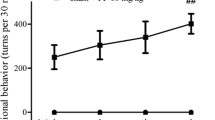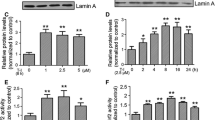Abstract
Parkinson's disease (PD) is one of the most common motor disorders in humans, associated with damage to the dopaminergic cells in the brain. Parkinson's disease is caused by chronic inflammation, mitochondrial dysfunction, oxidative stress and loss of dopaminergic neuronal cells in the dense part of the basal ganglia. In the present study, the neuroprotective effect of Abscisic acid (ABA) on 6-hydroxy-dopamine (6-OHDA)-induced cellular damage in dopaminergic SH -SY5Y cells of neuroblastoma as an in vitro model of Parkinson's disease was investigated. Since abscisic acid has anti-inflammatory effects, this study investigated the effect of ABA on neuronal inflammation by 6-hydroxydopamine in vitro. To induce cytotoxicity, the above cells were treated with 150 μM 6-hydroxydopamine, then the effective dose of ABA (100 μM) was used in the treatment groups. Then the biochemical parameters of neuronal inflammation (COX -2 and TNF-α) were measured. The results of this study showed that 6-hydroxy-dopamine increased the cellular damage and expression of COX -2 and TNF-α, and treatment with an effective dose of ABA (100 μM) reduced the aforementioned cellular and molecular abnormalities. Therefore, it appears that ABA has a neuroprotective effect against 6-hydroxydopamine-induced neuronal inflammation in vitro.
Similar content being viewed by others
Data availability
The data will be made available upon request.
References
Alexander GE (2004) Biology of Parkinson’s disease: pathogenesis and pathophysiology of amultisystem neurodegenerative dis-order. Dialogues Clin Neurosci 6(3):259–280
Baliño P, Gómez-Cadenas A, López-Malo D, Romero FJ, Muriach M (2019) Is there a role for abscisic acid, a proven anti-inflammatory agent, in the treatment of ischemic retinopathies? Antioxidants 8(4):104
Bassaganya-Riera J, Guri AJ, Lu P, Climent M, Carbo A, Sobral BW, Horne WT, Lewis SN, Bevan DR, Hontecillas R (2011) Abscisic acid regulates inflammation via ligand-binding domain-independent activation of peroxisome proliferator-activated receptor γ. J Biol Chem 286(4):2504–2516
Bassaganya-Riera J, Skoneczka J, Kingston D, Krishnan A, Misyak S, Guri A, Pereira A, Carter A, Minorsky P, Tumarkin R (2010) Mechanisms of action and medicinal applications of abscisic acid. Curr Med Chem 17(5):467–478
Bassani TB, Vital MA, Rauh LK (2015) Neuroinflammation in the pathophysiology of Parkinson’s disease and therapeutic evidence of anti-inflammatory drugs. Arq Neuropsiquiatr 73:616–623
Booz V, Christiansen CB, Kuhre RE, Saltiel MY, Sociali G, Schaltenberg N, Fischer AW, Heeren J, Zocchi E, Holst JJ (2019) Abscisic acid stimulates the release of insulin and of GLP-1 in the rat perfused pancreas and intestine. Diabetes Metab Res Rev 35(2):e3102
Bruzzone S, Bodrato N, Usai C, Guida L, Moreschi I, Nano R, Antonioli B, Fruscione F, Magnone M, Scarfi S (2008) Abscisic acid is an endogenous stimulator of insulin release from human pancreatic islets with cyclic ADP ribose as second messenger. J Biol Chem 283(47):32188–32197
Chen K, Li GJ, Bressan RA, Song CP, Zhu JK, Zhao Y (2020) Abscisic acid dynamics, signaling, and functions in plants. J Integr Plant Biol 62(1):25–54
Çomoğlu SS, Güven H, Acar M, Öztürk G, Koçer B (2013) Tear levels of tumor necrosis factor-alpha in patients with Parkinson's disease. Neurosci Lett 553:63–67
Fan B, Jabeen R, Bo B, Guo C, Han M, Zhang H, Cen J, Ji X, Wei J (2020) What and how can physical activity prevention function on Parkinson’s disease? Oxidative Medicine and Cellular Longevity 2020
Guri AJ, Evans NP, Hontecillas R, Bassaganya-Riera J (2011) T cell PPARγ is required for the anti-inflammatory efficacy of abscisic acid against experimental IBD. J Nutr Biochem 22(9):812–819
Guri AJ, Hontecillas R, Bassaganya-Riera J (2010) Abscisic acid ameliorates experimental IBD by downregulating cellular adhesion molecule expression and suppressing immune cell infiltration. Clin Nutr 29(6):824–831
Guri AJ, Misyak SA, Hontecillas R, Hasty A, Liu D, Si H, Bassaganya-Riera J (2010) Abscisic acid ameliorates atherosclerosis by suppressing macrophage and CD4+ T cell recruitment into the aortic wall. J Nutr Biochem 21(12):1178–1185
Hirsch EC, Vyas S, Hunot S (2012) Neuroinflammation in Parkinson's disease. Parkinsonism Relat Disord 18:S210–S212
Jeon SH, Kim N, Ju Y-J, Gee MS, Lee D, Lee JK (2020) Phytohormone abscisic acid improves memory impairment and reduces neuroinflammation in 5xFAD mice by upregulation of LanC-Like protein 2. Int J Mol Sci 21(22):8425
Jin F, Wu Q, Lu Y-F, Gong Q-H, Shi J-S (2008) Neuroprotective effect of resveratrol on 6-OHDA-induced Parkinson's disease in rats. Eur J Pharmacol 600(1–3):78–82
Kalia LV, Kalia SK, Lang AE (2015) Disease-modifying strategies for Parkinson's disease. Mov Disord 30(11):1442–1450
Kang X, Qiu J, Li Q, Bell KA, Du Y, Jung DW, Lee JY, Hao J, Jiang J (2017) Cyclooxygenase-2 contributes to oxidopamine-mediated neuronal inflammation and injury via the prostaglandin E2 receptor EP2 subtype. Sci Rep 7(1):1–14
Khorasani A, Abbasnejad M, Esmaeili-Mahani S (2019) Phytohormone abscisic acid ameliorates cognitive impairments in streptozotocin-induced rat model of Alzheimer's disease through PPARβ/δ and PKA signaling. Int J Neurosci 129(11):1053–1065
Knott C, Stern G, Wilkin G (2000) Inflammatory regulators in Parkinson's disease: iNOS, lipocortin-1, and cyclooxygenases-1 and-2. Mol Cell Neurosci 16(6):724–739
Lievens L, Pollier J, Goossens A, Beyaert R, Staal J (2017) Abscisic acid as pathogen effector and immune regulator. Front Plant Sci 8:587
Ma, Q., B. Wu, Y. Lu, W. Chu and Y. Guo (1988). "The effect of induced differentiation of abscisic acid on human HCC cell line SMMC-7721." Journal of Kunming Medical University.
Magnone M, Sturla L, Guida L, Spinelli S, Begani G, Bruzzone S, Fresia C, Zocchi E (2020) Abscisic acid: A conserved hormone in plants and humans and a promising aid to combat prediabetes and the metabolic syndrome. Nutrients 12(6):1724
McGEER PL, McGEER EG (2004) Inflammation and the degenerative diseases of aging. Ann N Y Acad Sci 1035(1):104–116
Montgomery SL, Bowers WJ (2012) Tumor necrosis factor-alpha and the roles it plays in homeostatic and degenerative processes within the central nervous system. J Neuroimmune Pharmacol 7(1):42–59
Pasban-Aliabadi H, Esmaeili-Mahani S, Abbasnejad M (2017) Orexin-A protects human neuroblastoma SH-SY5Y cells against 6-hydroxydopamine-induced neurotoxicity: involvement of PKC and PI3K signaling pathways. Rejuvenation Res 20(2):125–133
Pasban-Aliabadi H, Esmaeili-Mahani S, Sheibani V, Abbasnejad M, Mehdizadeh A, Yaghoobi MM (2013) Inhibition of 6-hydroxydopamine-induced PC12 cell apoptosis by olive (Olea europaea L.) leaf extract is performed by its main component oleuropein. Rejuvenation Res 16(2):134–142
Qi C-C, Shu Y-M, Chen F-H, Ding Y-Q, Zhou J-N (2016) Sensitivity during the forced swim test is a key factor in evaluating the antidepressant effects of abscisic acid in mice. Behav Brain Res 300:106–113
Qi C-C, Zhang Z, Fang H, Liu J, Zhou N, Ge J-F, Chen F-H, Xiang C-B, Zhou J-N (2015) Antidepressant effects of abscisic acid mediated by the downregulation of corticotrophin-releasing hormone gene expression in rats. International Journal of Neuropsychopharmacology 18(4)
Rafiepour K, Esmaeili-Mahani S, Salehzadeh A, Sheibani V (2019) Phytohormone abscisic acid protects human neuroblastoma SH-SY5Y cells against 6-hydroxydopamine-induced neurotoxicity through its antioxidant and antiapoptotic properties. Rejuvenation Res 22(2):99–108
Sakthivel P, Sharma N, Klahn P, Gereke M, Bruder D (2016) Abscisic acid: a phytohormone and mammalian cytokine as novel pharmacon with potential for future development into clinical applications. Curr Med Chem 23(15):1549–1570
Sánchez-Sarasúa S, Moustafa S, García-Avilés Á, López-Climent MF, Gómez-Cadenas A, Olucha-Bordonau FE, Sánchez-Pérez AM (2016) The effect of abscisic acid chronic treatment on neuroinflammatory markers and memory in a rat model of high-fat diet induced neuroinflammation. Nutrition & metabolism 13(1):1–11
Shrivastava P, Vaibhav K, Tabassum R, Khan A, Ishrat T, Khan MM, Ahmad A, Islam F, Safhi MM, Islam F (2013) Anti-apoptotic and anti-inflammatory effect of Piperine on 6-OHDA induced Parkinson's rat model. J Nutr Biochem 24(4):680–687
Simola N, Morelli M, Carta AR (2007) The 6-hydroxydopamine model of Parkinson’s disease. Neurotox Res 11(3):151–167
Teismann P (2012) COX-2 in the neurodegenerative process of Parkinson's disease. BioFactors 38(6):395–397
Tolleson CM, Fang JY (2013) Advances in the mechanisms of Parkinson’s disease. Discov Med 15(80):61–66
Troncoso-Escudero, P., A. Parra, M. Nassif and R. L. Vidal (2018). "Outside in: Unraveling the Role of Neuroinflammation in the Progression of Parkinson's Disease." Frontiers in neurology 9: 860.
Xicoy H, Wieringa B, Martens GJ (2017) The SH-SY5Y cell line in Parkinson’s disease research: a systematic review. Mol Neurodegener 12(1):1–11
Acknowledgments
The authors express their gratitude to the staff of Neuroscience Research Center, Kerman University of Medical Sciences.
Funding
This project was supported by a grant from the Neuroscience Research Center of Kerman University of Medical Sciences, Kerman, Iran.
Author information
Authors and Affiliations
Contributions
All the authors met the standard writing criteria based on the recommendations of International Committee of Medical Journal Publishers.
Corresponding author
Ethics declarations
Conflict of interest
The authors declare that there is no conflict of interest in the current study
Rights and permissions
Springer Nature or its licensor (e.g. a society or other partner) holds exclusive rights to this article under a publishing agreement with the author(s) or other rightsholder(s); author self-archiving of the accepted manuscript version of this article is solely governed by the terms of such publishing agreement and applicable law.
About this article
Cite this article
Rafiepour, K., Salehzadeh, A., Bahadori, P. et al. Abscisic acid decreases expression of COX-2 and TNF-α proteins in SH-SY5Y neuroblastoma cells as an in vitro model of Parkinson's disease. Neurosci Behav Physi 53, 688–694 (2023). https://doi.org/10.1007/s11055-023-01362-3
Received:
Accepted:
Published:
Issue Date:
DOI: https://doi.org/10.1007/s11055-023-01362-3




